Last Updated: October 4, 2023
Have you ever wondered why membership organizations offer different membership levels? 🤔
What purpose do they serve, and why are they so crucial in today’s landscape? 🤔
Membership levels, in essence, represent a stratification system within an organization that categorizes its members based on various criteria. 🪜
These criteria can include factors such as the level of financial commitment, duration of membership, or the extent of benefits and privileges provided to each tier.
📚 Why You Should Read This? 📚
Curious about what the membership level is? We’ll decode their secrets, explaining how and why they’re used, so you can make the most of them.
We are ready to expose you to everything you wonder about at the membership levels, please keep scrolling!
🔑 Key Points We’ll Explore:
- What are membership levels?
- Understanding Membership Levels
- The Importance of Membership Level Names
- Key Elements of Effective Membership Levels
- What are the types of tiered membership levels?
- How many tiered memberships should you offer?
- How to Name Membership Levels
- The 8 Ways You Can Name Your Membership Levels
- The Examples Of Membership Levels
- Why are Membership Levels also important for Nonprofits?
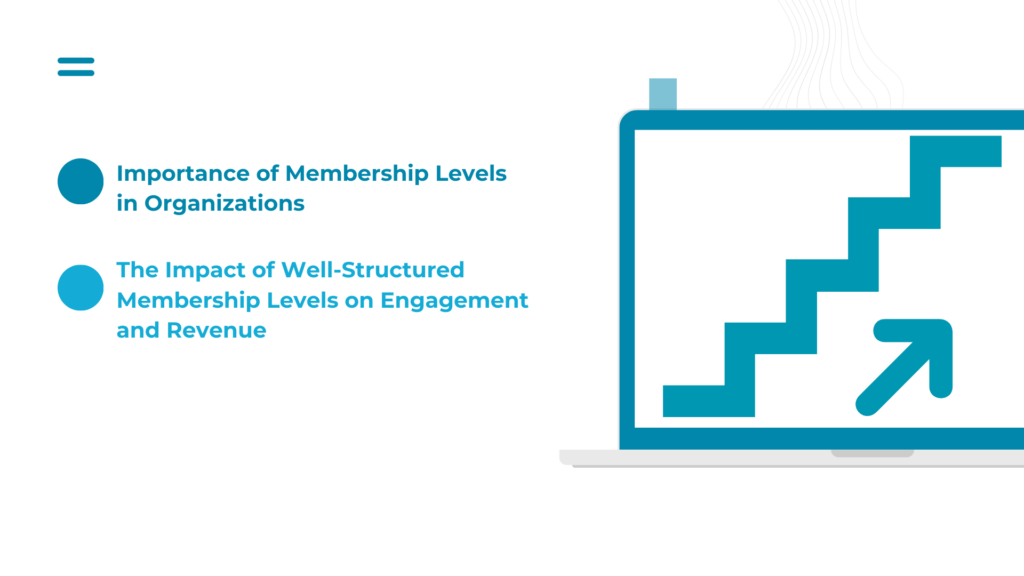
📢 Importance of Membership Levels in Organizations
Membership levels play a pivotal role in shaping the dynamics of organizations across various sectors.
Here are some key reasons why these tiers are of paramount importance:
- Tailored Engagement
- Resource Allocation
- Sustainable Revenue Streams
- Community Building
- Data Collection and Analysis
📌 The Impact of Well-Structured Membership Levels on Engagement and Revenue
A well-structured system of creating membership levels can have a profound impact on an organization’s ability to engage its members effectively and generate revenue.
It’s not just about offering tiers; it’s about doing so thoughtfully and strategically.
In the upcoming sections, we will explore how the careful design of membership levels can lead to enhanced engagement and increased revenue for organizations.
What are Membership Levels?

Organizations set up membership levels as a hierarchy or system to divide their members into groups based on different factors, like how much money they spend, how long they stay a member, or the range of perks and privileges they get.
These levels are meant to give users a range of levels of involvement, access, and services to meet their individual needs and desires.
Here’s a more in-depth look at what each membership level usually includes:
Tiered Structure: Usually, membership levels are set up in levels, or “tiers.” Each level gives you a different set of perks or rights.
Benefits and Privileges: Members at higher levels usually get a wider range of benefits and privileges than members at lower levels. Some examples of these perks are early entry, discounts, special events, etc.
Financial Commitment: Each level of participation has a different cost. For higher-level groups, you usually have to make a bigger financial commitment, like paying more in fees or dues every year.
Duration of Membership: When deciding a person’s level of membership, some groups may look at how long they plan to stay a member. Loyal or long-term users may be able to move up to higher levels or get more benefits.
Personalization: Different levels of membership let groups connect with members in ways that are relevant to their wants and needs.
Access and Exclusivity: Certain members can see or use special material, events, or services that other members can’t. This level of exclusivity can be a big reason for members to improve their contracts.
Community and Recognition: Different stages of membership can also help people feel like they are part of a group and get noticed.
Understanding Membership Levels
We want you to understand some concepts before we dive deeper!
The term membership levels refers to a method that groups use to divide their members into different levels or categories.
These levels are different based on things like financial investment, length of membership, and the number of perks provided.
Different Types of Organizations That Benefit From Membership Structures
Different types of organizations can use membership structures because they are flexible.
Here are some examples of groups that would gain from having different levels of membership:
Nonprofit Organizations

Membership arrangements are a common way for nonprofits to get donors, workers, and fans involved.
They can recognize and thank people at different levels of commitment, from basic fans to big donors, through different membership levels.
Professional Associations
Some groups, like medical or bar associations, have different levels of participation to meet the needs of professionals at different times of their jobs.
Members who are younger may have different wants and access than members who are older.

Cultural and Arts Institutions
Museums, plays, and other cultural institutions often have membership levels that give members special access to events, shows, and exhibitions.
Some perks that come with higher levels of membership are special trips and invitations to sneak peeks.

Online Communities
Membership ranks are often used to tell the difference between busy contributors, moderators, and regular members in online communities like forums, social media sites, and other online groups.

Benefits of Offering Multiple Membership Levels
Having more than one level of membership can help organizations in many ways, such as:

- Diverse Engagement: Offering choices that fit a range of hobbies and costs through different membership levels helps groups connect with more people. This openness can bring in a bigger group of people and supporters.
- Revenue Generation: Organizations can make money through membership fees or dues by giving different kinds of perks and privileges. Fees are usually higher for higher-level groups with better perks, which helps keep the business going.
- Customization: Each member can pick the amount that meets their wants and tastes the best. This customization makes members happier and more likely to stay with the company.
- Resource Allocation: Organizations can use their resources more wisely if they give different levels of people different perks and services. This makes the best use of money, staff time, and other resources.
- Data Collection and Analysis: The amount of membership gives us useful information about how members act and what they like. By looking at this data, businesses can improve their plans, get more people involved, and make decisions based on facts.
- Community Building: Different levels of membership can help members feel like they belong and are part of a group, which can make them more loyal and dedicated to the organization’s mission or goals.
The Importance of Membership Level Names
The titles of each tier or category in an organization’s membership structure affect the prospective members and the organization’s performance.
Here’s how membership names affect retention, engagement, and revenue:
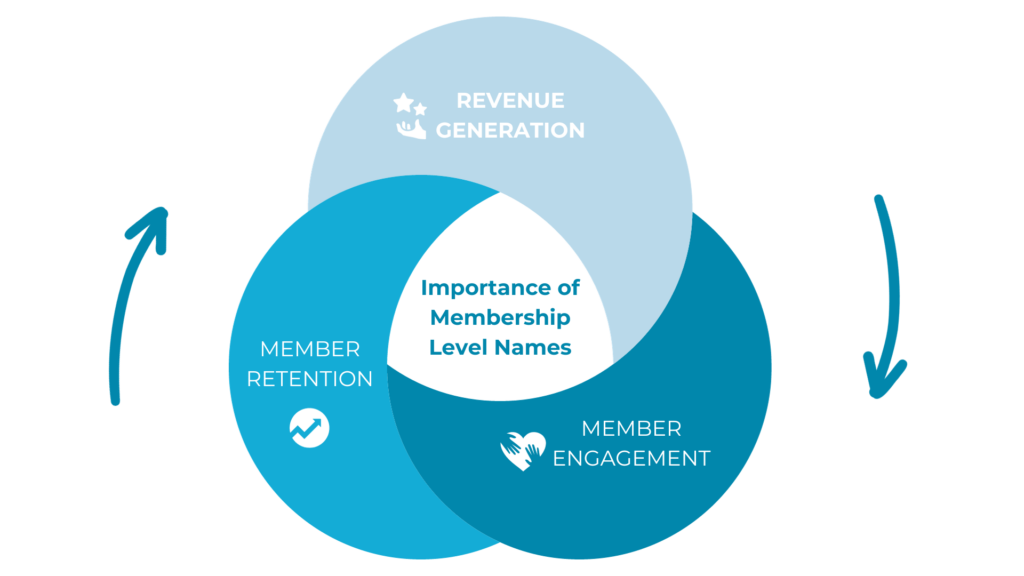
Increased Member Retention
Members feel identified and connected by creative membership level names. Well-written level names help members identify with their tier and strengthen their commitment to the organization.
When members experience a feeling of belonging and loyalty, they are less inclined to lapse or cancel.
Enhanced Member Engagement
Members might be motivated to reach higher tiers with membership level naming strategy.
Members may upgrade when the membership names are appealing and reflect a feeling of success or exclusivity.
Higher engagement can enhance participation in events, activities, and organizational relationships.
Improved Revenue Generation
Creative membership level names can greatly impact income. Potential members can quickly comprehend each tier’s perks when level names express value and rewards.
This clarity may encourage more people to buy higher-tier memberships, increasing income.
In short, here are some reasons why the names of membership levels are important:
- Membership level names are important for branding because they give the group a unique look.
- Having a catchy name gets both possible members and current members excited and interested.
- By giving each membership level a clear name, you can help members understand what perks and rights come with each level.
- The names of membership level affect how valuable and important each tier is seen to be.
- Names that are well-thought encourage members to move up and reach for higher levels.
- Names that are easy to remember make an emotional connection and help people feel like they belong.
- Members are more likely to stay with a club whose name your membership levels they like.
Key Elements of Effective Membership Levels
Effective membership levels must address members’ different requirements and preferences while maintaining the organization’s viability and development.
Here are the key elements to consider:
1-Different Organizations’ Customization
Membership levels should reflect the organization’s aims, offerings, and demographics. What works for a nonprofit may not for a gym or online community. Customization matches the membership structure to the organization’s goal and audience.
2-Pricing Strategies and Considerations
Pricing is key to membership tiers. It’s crucial to balance affordability with revenue to fund the organization. Pricing should reflect benefits’ perceived value and target audience financial capacity. To suit different budgets, offer monthly memberships, yearly memberships, or lifetime subscriptions.
3-Access Exclusive Content and Benefits
Access to unique information, incentives, and privileges drives membership. Benefits should be clearly stated at each membership level. Premium material, early event registration, product discounts, customized assistance, and special member-only events may be offered.
4-Duration/Renewal
Carefully consider membership length and renewal choices. Members may choose lifetime or yearly renewals. Members should be advised of approaching renewals to reduce lapses and simplify the renewal process.
5-Tier Progression and Goals
Design membership levels that encourage tier advancement. Offering more value and rewards at each stage makes advancement evident. This can encourage active participation and investment.
6-Rememberable Level Names:
Membership level titles should be straightforward, memorable, and represent each tier’s value. Avoid names that confuse members about what they get.
What Are the Types of Tiered Membership Levels?
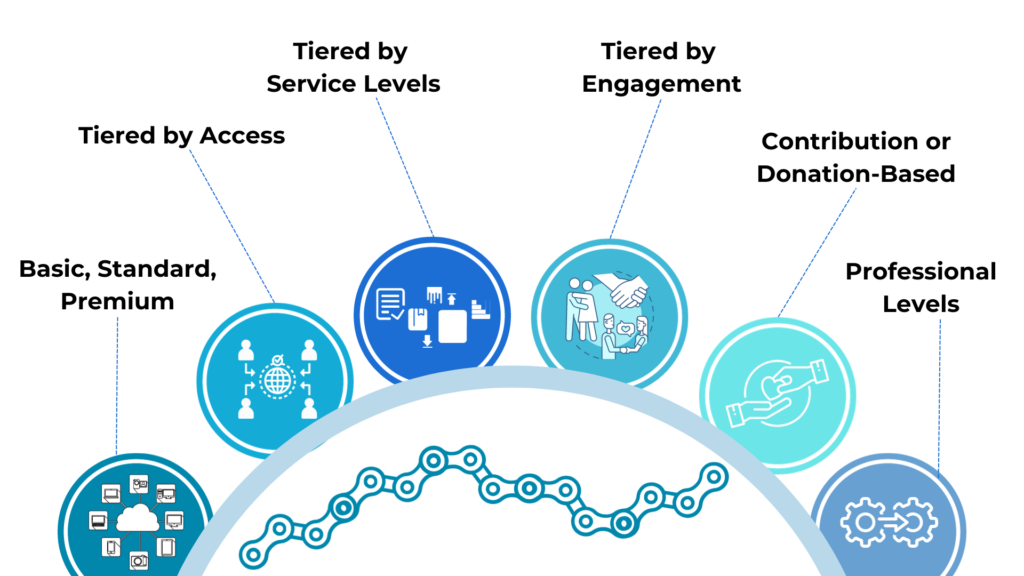
Basic, Standard, Premium
This tiered membership level gives you three levels of membership: basic, standard, and premium. Basic membership gives you the most basic benefits, Standard gives you a good mix of benefits, and Premium gives you the most benefits and rights.
Tiered by Access
In this tiered membership level, different membership level names are based on what benefits, services, or resources they can use. Higher tiers give members more access, to special material or monthly access to advanced tools that lower-tier members don’t have.
Tiered by Service Levels
In this type of naming structure for membership tier, the different levels are based on how much service or help the person gets. Higher-tier members may have early access to account managers, personalized help, or customer support.
Tiered by Engagement
This membership tier groups people into groups based on how much they are involved with the company. It could have levels like casual member, active member, and engaged member, with each level giving more engagement, support, or interest in the community.
Contribution or Donation-Based
Members are recognized in this system based on how much money they have given to the group. It can have levels like supporter and charitable; each level shows how committed the person is to giving money to the group.
Professional Levels
This kind of membership tier is designed for professional groups or clubs. It has different stages of membership based on work accomplishments, qualifications, or how long someone has been a member.
How Many Tiered Memberships Should You Offer?
The number of tiered memberships you should offer depends on several factors, including your organization’s goals, audience, and the value you can provide at each membership level.
Here are some considerations to help you determine the right number of tiered memberships:
Factor #1: Audience Segmentation
Consider your audience and their diverse needs and preferences. Offering multiple tiers allows you to cater to different segments of your audience.

Factor #2: Pricing Strategy
Determine the pricing for each tier based on the perceived value and what your audience is willing to pay. Be mindful not to overcomplicate pricing, as too many tiers can confuse potential customers.
Factor #3: Operational Capacity
Consider your ability to manage and deliver on the promises of each tier. Offering too many tiers with complex benefits can become difficult to manage and may lead to operational challenges.

Factor #4: Competitive Analysis
Research what your competitors are offering in terms of membership tiers. This can help you differentiate your offerings and find a unique selling proposition.
How to Name Membership Levels
To make sure the names fit with your organization’s or membership site’s app, ideals, and target group, you need to think carefully about how to naming your membership levels.
Here are some steps to help you come up with good names for your membership levels:
- Understand your audience
Learn as much as you can about your target audience’s hobbies, goals, and beliefs. This will help you come up with names that make them feel like they fit.
- Reflect benefits and differentiation
Think about the different perks and rights that come with each participation level like special membership site or exclusive subscription tiers. Use names that show these perks, and make it clear which tier is which.

- Match with your organization
Make sure that the names of your membership levels fit with the brand and character of your organization as a whole. Choose names that fit with the tone, beliefs, and message of your organization’s brand name.
- Be specific and easy to remember
Use names that are clear and explain what each level means. This will help members understand the importance of each level quickly. Also, try to come up with names that stand out and are easy to remember. This will make it more likely that people will remember them.

- Consider aspirational names
Add words that sound like goals to the names of your membership levels to give them a sense of respect and encourage people to move up.
- Use imagery and metaphors
Think about using images or metaphors that fit with the purpose or industry of your company. This can make the participation levels more interesting and help people feel something.

- Test and feedback
When you’ve created a list of possible names, try them out on a small group of people or ask current members what they think. This will help you see how they react and make sure that the names are meaningful to the people you want to reach.
The 8 Ways You Can Name Your Membership Levels
There are many ways to come up with names for naming your membership levels that are memorable and interesting.
By carefully choosing the naming structure, you can come up with interesting names that connect with your audience and tell them what each membership level is worth.
Way 1: Descriptive Naming
Each membership level should have a name that describes the perks or features that come with it. This simple method makes it easy for prospective members to see what the differences are between the tiers.
Way 2: Achievement-based Naming
This way of bringing people together shows how they have grown and accomplished things in the program. These kinds of names give members who reach higher tiers a sense of progress and recognition.
Way 3: Exclusivity-based Naming
Exclusivity-based names that are based on exclusivity try to make higher-tier members feel important and special. This method attracts premium members who want access to special content delivery perks and customized experiences.
Way 4: Story-based Naming
The names of the membership classes have something to do with a story. Each level is a step or part of a member’s progress through the program. This method gets members interested by tying their participation experience to an interesting story.
Way 5: Benefit-driven Naming
Benefit-driven names show the exact benefits or perks that come with each level of membership. This method puts the focus on the value and specific perks of each tier, which draws in members who want those specific perks.
Way 6: Figurative Naming
Metaphorical names use pictures or words to show the different levels of involvement. This method gives the membership experience more depth and visuals.
Way 7: Creative Names for Adjectives
Creative words give the membership classes a bit of personality and make them stand out. These kinds of names make you feel something and make you curious, which makes the membership levels easier to remember and more interesting.
Way 8: Naming by numbers
Names with numbers make it clear and easy to see how the participation program works. This makes it easier to see how the different levels fit together in a hierarchy.
The Examples Of Membership Levels
- Membership Level Names Based On User Type – Spotify
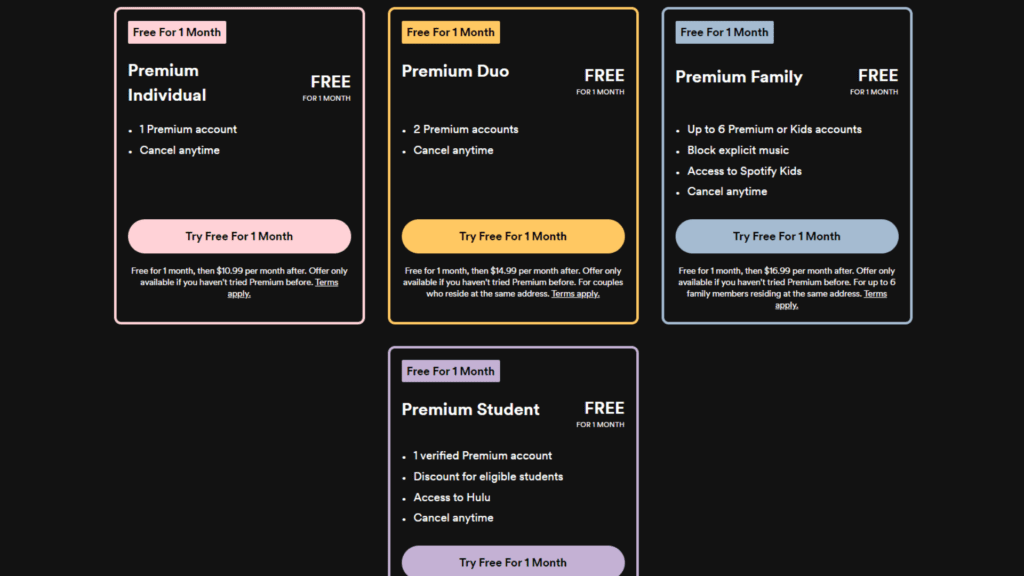
They offer on their membership sites four own membership levels of monthly and annual subscriptions: Individual, Duo, Family, and Student. They set up each membership program to appeal to a certain type or group of users.
- Membership Level Names Based On Skill – Treehouse
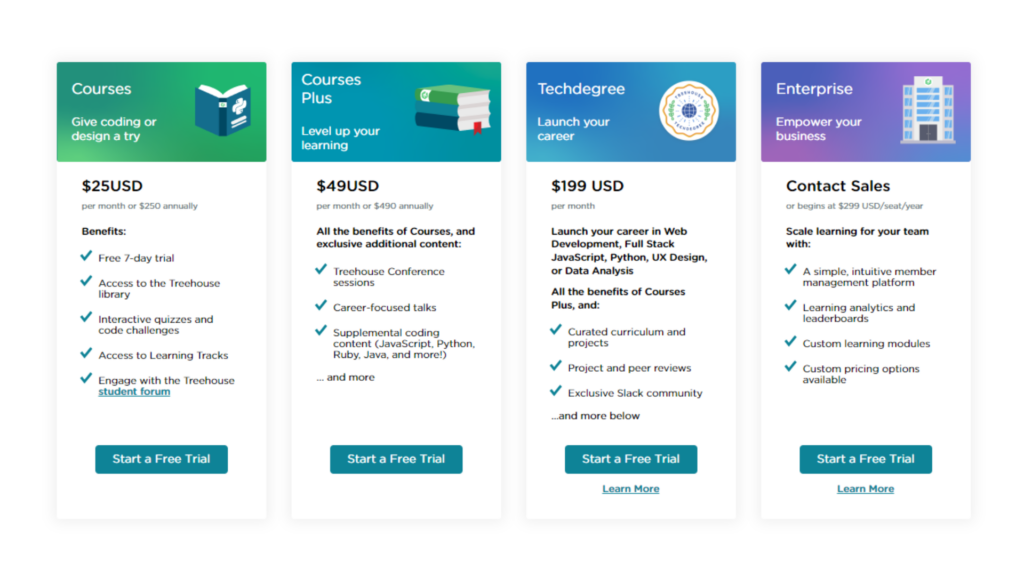
Treehouse membership site has several Techdegree classes where you can learn about a certain subject and get a license. Courses, Courses Plus, Techdegree, and Enterprise are all part of the Techdegree study. They named creative membership level names for the different stages.
- Membership Level Names Based On Interest – TradersFly

TradersFly membership site has various membership program options and plans that let you get information on stock charts and trade stocks successfully using technical analysis. They named the different membership tiers and plans in a way that gives people a general idea of the kinds of services they could have.
Why are Membership Levels also important for Nonprofits?
Membership levels are very important for nonprofits because they allow for organized involvement, different ways to make money, and building communities.
Nonprofits can effectively engage fans, make the most of their impact, and give their members a sense of belonging by having a clear membership level.
Here are some reasons why membership levels are also important for nonprofits:
- Revenue Generation
Nonprofits can organize revenue via membership tiers. Nonprofits can attract donors of various sizes by using membership fees or offering multiple membership classes with variable costs. This revenue diversification protects the organization’s goals and programs.
- Improved Engagement
Membership drives nonprofit involvement. Each level may include special events, early program access, or personalized communication. This boosts potential members and current members loyalty, involvement, and advocacy.
- Donor Care
Nonprofits need strong supporters’ connections. Nonprofits can thank members through membership level. Nonprofits may show gratitude to loyal members and improve donor stewardship by offering higher-level memberships and incentives.
- Volunteer Work
Membership in a professional organization might entail voluntary work. Depending on volunteer activity, nonprofits can recognize and reward volunteers. This increases volunteerism, ownership, and influence of nonprofit organizations.
- Community Building
Nonprofit foster membership community. Nonprofits may connect like-minded supporters by offering a framework for members to identify themselves at multiple levels. This common identity and sense of belonging may encourage cooperation, information sharing, and a collaborative effect on the organization’s purpose.
Last Words on Membership Levels
Congratulations!
You have come to the end of the article, and we hope you found everything you were looking for.
Briefly, what did we talk about?
Membership levels are vital for organizations as they enable tailored engagement, revenue generation, membership community building, and data collection.
Well-structured levels impact engagement and revenue positively. The number of tiers should align with your goals and audience.
Thoughtful level names enhance retention, engagement, and revenue.
Whether in nonprofits or businesses, membership levels are a valuable strategy for success.
FAQs about Membership Levels
1-What are membership levels?
Members get different perks depending on how much they pay, how long they stay a member, or how involved they are in the organization.
2-Why offer membership levels?
Different levels of membership can help organizations make more money, get and keep members, thank members for their support, and give members different perks to meet their needs.
3-What are the different types of membership levels?
Individual membership levels, group membership levels, and company membership levels are all popular types of membership levels.
4-What are the different types of membership levels?
It’s important to think about your wants and funds when picking a membership level. You should think about what perks are important to you and how often you want to use them. You should also look at the benefits of each membership level and choose the one that gives you the most for your money.
5-How do I upgrade or downgrade my membership level?
It’s usually easy to change your membership level with most groups. Most of the time, you can do this through your online account or by calling the group directly.







